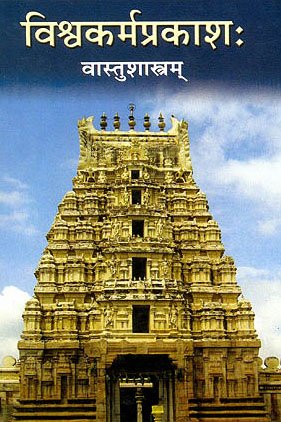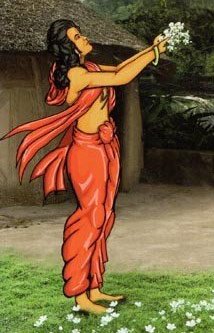Niketa: 17 definitions
Introduction:
Niketa means something in Hinduism, Sanskrit, Buddhism, Pali, Hindi. If you want to know the exact meaning, history, etymology or English translation of this term then check out the descriptions on this page. Add your comment or reference to a book if you want to contribute to this summary article.
Alternative spellings of this word include Niket.
In Hinduism
Vastushastra (architecture)
Source: Wisdom Library: Vāstu-śāstraNiketa (निकेत) is a Sanskrit technical term denoting a “residence” in general, according to the lists of synonyms given in the Samarāṅgaṇa-sūtradhāra XVIII.8-9, which is a populair treatise on Vāstuśāstra literature.

Vastushastra (वास्तुशास्त्र, vāstuśāstra) refers to the ancient Indian science (shastra) of architecture (vastu), dealing with topics such architecture, sculpture, town-building, fort building and various other constructions. Vastu also deals with the philosophy of the architectural relation with the cosmic universe.
Purana and Itihasa (epic history)
Source: Cologne Digital Sanskrit Dictionaries: The Purana IndexNiketa (निकेत).—Dwellings built at the end of Kṛtayuga in Marudhanva, Nimna, Parvata, Nadi and Dhanva; the latter fortresses to protect from the sun and rain.*
- * Vāyu-purāṇa 8. 96-97.

The Purana (पुराण, purāṇas) refers to Sanskrit literature preserving ancient India’s vast cultural history, including historical legends, religious ceremonies, various arts and sciences. The eighteen mahapuranas total over 400,000 shlokas (metrical couplets) and date to at least several centuries BCE.
Kavya (poetry)
Source: Wisdom Library: KathāsaritsāgaraNiketa (निकेत) or Niketādri is the name of a mountain whose lord is named Kākaṇḍaka: a Vidyādhara king who fought on Śrutaśarman’s side but was slain by Prabhāsa, who participated in the war against Sūryaprabha, according to the Kathāsaritsāgara, chapter 48. Accordingly: “... when they heard that [speech of Śrutaśarman], eight warriors in anger surrounded Prabhāsa.... And the fifth was Darpavāha by name, lord of the hill Niketa, and the sixth was Dhūrtavyayana, the lord of the mountain Añjana, and both these Vidyādharas were chiefs of excellent warriors”.
The Kathāsaritsāgara (‘ocean of streams of story’), mentioning Niketa, is a famous Sanskrit epic story revolving around prince Naravāhanadatta and his quest to become the emperor of the vidyādharas (celestial beings). The work is said to have been an adaptation of Guṇāḍhya’s Bṛhatkathā consisting of 100,000 verses, which in turn is part of a larger work containing 700,000 verses.

Kavya (काव्य, kavya) refers to Sanskrit poetry, a popular ancient Indian tradition of literature. There have been many Sanskrit poets over the ages, hailing from ancient India and beyond. This topic includes mahakavya, or ‘epic poetry’ and natya, or ‘dramatic poetry’.
Languages of India and abroad
Pali-English dictionary
Source: BuddhaSasana: Concise Pali-English Dictionaryniketa : (nt.) abode; home.
Source: Sutta: The Pali Text Society's Pali-English DictionaryNiketa, (Sk. niketa settlement, ni+cināti) 1. house, abode Dh. 91 (=ālaya DhA. II, 170).—2. (fig.) company, association. (In this sense it seems to be interpreted as belonging to ketu “sign, characteristic, mark, ” and niketa-sārin would have to be taken as “following the banner or flag of ... , ” i.e. belonging or attached to, i.e. a follower of, one who is devoted to.) a° not living in company, having no house Sn. 207; Miln. 244 (+nirālaya).

Pali is the language of the Tipiṭaka, which is the sacred canon of Theravāda Buddhism and contains much of the Buddha’s speech. Closeley related to Sanskrit, both languages are used interchangeably between religions.
Sanskrit dictionary
Source: DDSA: The practical Sanskrit-English dictionaryNiketa (निकेत).—
1) A house, habitation, mansion, abode; श्रितगोकर्णनिकेतमीश्वरम् (śritagokarṇaniketamīśvaram) R.8.33;14.58; Bhagavadgītā (Bombay) 12.19; Kumārasambhava 5.25; Manusmṛti 6.26; Śiśupālavadha 5.26.
2) A mark, countersign.
3) A stage in the religious life of a Brāhmaṇa; Mahābhārata (Bombay) 3.
Derivable forms: niketaḥ (निकेतः).
See also (synonyms): niketaka.
Source: Cologne Digital Sanskrit Dictionaries: Edgerton Buddhist Hybrid Sanskrit DictionaryNiketa (निकेत).—(m. or nt.), state of existence, life: paścime bhave paścime nikete paścime samucchraye paścima ātma- bhāvapratilambhe Divyāvadāna 70.2; 73.16; niketa-sthānāni, bases for (further) lives, Daśabhūmikasūtra 39.23, quoted s.vv. un- miñjita, kelāyati (4).
Source: Cologne Digital Sanskrit Dictionaries: Shabda-Sagara Sanskrit-English DictionaryNiketa (निकेत).—m.
(-taḥ) A house, a habitation. E. ni in, kit to dwell, affix ghañ; also with yuca affix niketana.
Source: Cologne Digital Sanskrit Dictionaries: Benfey Sanskrit-English DictionaryNiketa (निकेत).—i. e. ni-kit + a, m. 1. A mansion, Mahābhārata 3, 8358. 2. A countersign, 12541.
Source: Cologne Digital Sanskrit Dictionaries: Cappeller Sanskrit-English DictionaryNiketa (निकेत).—[masculine] ([neuter]) habitation, abode, house; order of the relig. life of a Brahman; mark, sign.
Source: Cologne Digital Sanskrit Dictionaries: Monier-Williams Sanskrit-English Dictionary1) Niketa (निकेत):—[=ni-keta] m. rarely n. (√4. cit) a mark, sign, [Mahābhārata iii, 12541] (tapātyaya-n, ‘mark of departure of heat’, said of a cloud)
2) [v.s. ...] a house, habitation, [Mahābhārata; Kāvya literature] etc.
3) [v.s. ...] seat of one of the constituent elements of the body, [Caraka]
4) [v.s. ...] a bee-hive (?), [Mahābhārata xi, 140]
5) [v.s. ...] a stage in the religious life of a Brāhman, [iii, 13411]
6) [v.s. ...] state of being, [Divyāvadāna]
Source: Cologne Digital Sanskrit Dictionaries: Yates Sanskrit-English DictionaryNiketa (निकेत):—[ni-keta] (taḥ) 1. m. A house.
Source: DDSA: Paia-sadda-mahannavo; a comprehensive Prakrit Hindi dictionary (S)Niketa (निकेत) in the Sanskrit language is related to the Prakrit word: Ṇikeya.
[Sanskrit to German]
Sanskrit, also spelled संस्कृतम् (saṃskṛtam), is an ancient language of India commonly seen as the grandmother of the Indo-European language family (even English!). Closely allied with Prakrit and Pali, Sanskrit is more exhaustive in both grammar and terms and has the most extensive collection of literature in the world, greatly surpassing its sister-languages Greek and Latin.
Hindi dictionary
Source: DDSA: A practical Hindi-English dictionaryNiketa (निकेत) [Also spelled niket]:—[[~na]] (nm) a house, residence; abode.
...
Kannada-English dictionary
Source: Alar: Kannada-English corpusNikēta (ನಿಕೇತ):—[noun] the place where a person normally resides; a house.
Kannada is a Dravidian language (as opposed to the Indo-European language family) mainly spoken in the southwestern region of India.
See also (Relevant definitions)
Starts with: Niketadri, Niketaka, Niketam, Niketana, Niketasarin, Niketasayana, Niketavant, Niketavasin.
Ends with: Aniketa, Calaniketa, Catushpadaniketa, Catushpathaniketa, Chatushpadaniketa, Padaniketa, Samketaniketa, Shriniketa, Viniketa, Vrikshabashpaniketa, Vrikshavasyaniketa.
Full-text (+8): Aniketa, Niketana, Padaniketa, Catushpathaniketa, Niketaka, Aniketana, Niketam, Niketavant, Nikeya, Samketaniketa, Vrikshavasyaniketa, Niket, Viniketa, Niketasayana, Calaniketa, Balimant, Niketavasin, Shriniketa, Niketasarin, Caraka.
Relevant text
Search found 12 books and stories containing Niketa, Ni-keta, Nikēta; (plurals include: Niketas, ketas, Nikētas). You can also click to the full overview containing English textual excerpts. Below are direct links for the most relevant articles:
Sahitya-kaumudi by Baladeva Vidyabhushana (by Gaurapada Dāsa)
Manusmriti with the Commentary of Medhatithi (by Ganganatha Jha)
Verse 6.43 < [Section VI - Procedure of going forth as a Wandering Mendicant]
Verse 6.25 < [Section III - Details of the Hermit’s Life]
Mahabharata (English) (by Kisari Mohan Ganguli)
Section X < [Lokapala Sabhakhayana Parva]
Consciousness in Gaudapada’s Mandukya-karika (by V. Sujata Raju)
The true nature of reality < [Chapter 4: Study of Māṇḍūkya Kārikā: Vaitathya Prakaraṇa]
Charaka Samhita (English translation) (by Shree Gulabkunverba Ayurvedic Society)
Chapter 5 - Body-channels (srotas-vimana) < [Vimanasthana (Vimana Sthana) — Section on Measure]
Shrimad Bhagavad-gita (by Narayana Gosvami)
Verse 2.45 < [Chapter 2 - Sāṅkhya-yoga (Yoga through distinguishing the Soul from the Body)]